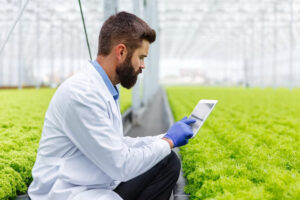
Introduction: The agricultural industry is undergoing a transformative shift as it embraces the power of technology. The convergence of agriculture and technology, often referred to as AgriTech, is reshaping the way crops are grown, harvested, and distributed. This article explores how AgriTech innovations are revolutionizing the agricultural landscape, improving efficiency, sustainability, and global food security.
- Precision Farming with IoT: Internet of Things (IoT) devices are increasingly being deployed in agriculture to enable precision farming. Sensors monitor soil moisture, nutrient levels, and weather conditions in real-time, allowing farmers to make informed decisions about irrigation, fertilization, and pest control. This data-driven approach optimizes resource utilization and minimizes environmental impact.
- Smart Machinery and Automation: AgriTech is ushering in a new era of smart machinery and automation. Autonomous tractors, robotic harvesters, and drones are transforming labor-intensive processes, reducing human intervention, and enhancing operational efficiency. This not only addresses labor shortages but also increases productivity across the agricultural value chain.
- Data-Driven Decision-Making: Data analytics and artificial intelligence are providing farmers with valuable insights into crop health, disease detection, and yield prediction. By analyzing historical and real-time data, farmers can make more accurate decisions about planting, harvesting, and managing resources, leading to improved yields and profits.
- Sustainable Practices with Precision Agriculture: AgriTech is driving the adoption of sustainable practices through precision agriculture techniques. Farmers can tailor their actions to specific areas of a field, minimizing overuse of fertilizers and pesticides. This not only reduces environmental impact but also enhances soil health and long-term sustainability.
- Blockchain in Supply Chain Transparency: Blockchain technology is being harnessed to improve transparency and traceability in the agricultural supply chain. From seed to table, consumers can track the journey of their food products, ensuring authenticity, quality, and ethical sourcing practices.
- Vertical Farming and Controlled Environments: AgriTech is facilitating the growth of vertical farming and indoor agriculture. With controlled environments, LED lighting, and hydroponic systems, crops can be grown in urban settings year-round. This approach reduces the need for large land areas, conserves water, and eliminates exposure to external weather conditions.
- Climate Resilience and Adaptive Farming: Climate change poses significant challenges to agriculture. AgriTech solutions are helping farmers adapt by providing weather forecasts, early warning systems, and predictive models for disease outbreaks. These tools enable proactive responses to changing environmental conditions.
- Access to Markets through AgriTech Platforms: Digital platforms and AgriTech marketplaces connect farmers directly with buyers, eliminating intermediaries and improving market access. This empowers small-scale farmers to reach broader markets, negotiate fair prices, and improve their economic livelihoods.
Conclusion: The AgriTech revolution is propelling the agricultural industry into a new era of innovation, efficiency, and sustainability. With the integration of IoT, automation, data analytics, and blockchain, farmers are empowered to make informed decisions, increase productivity, and contribute to global food security. As AgriTech continues to evolve, its potential to transform agriculture and improve livelihoods remains boundless.






